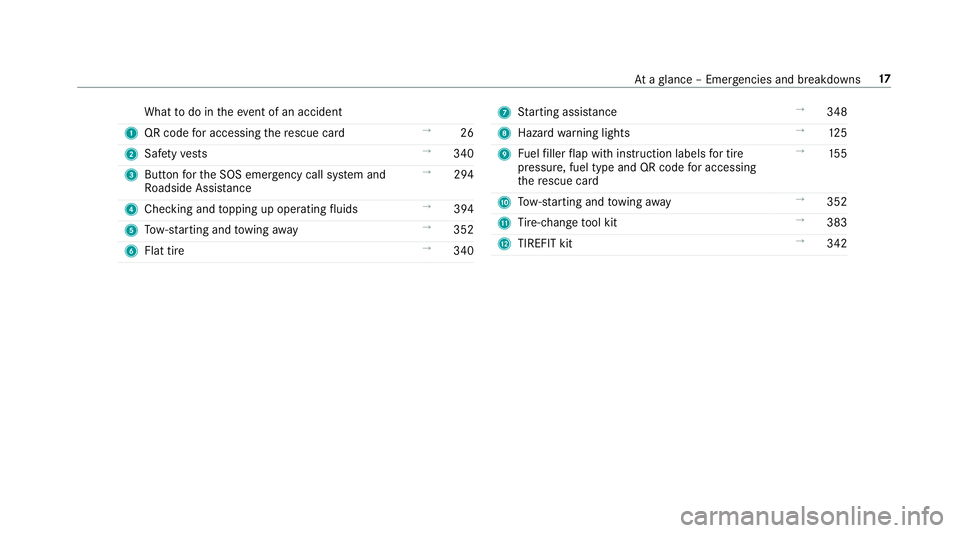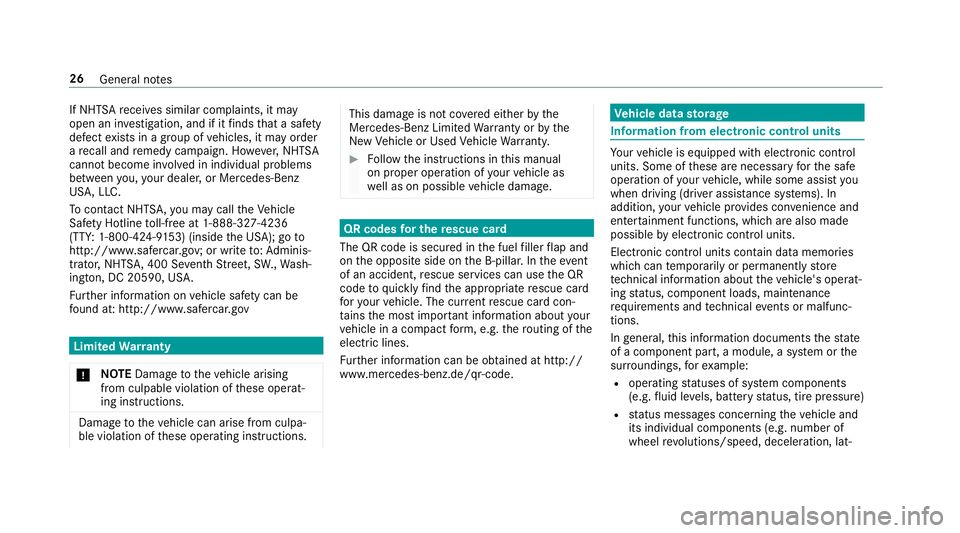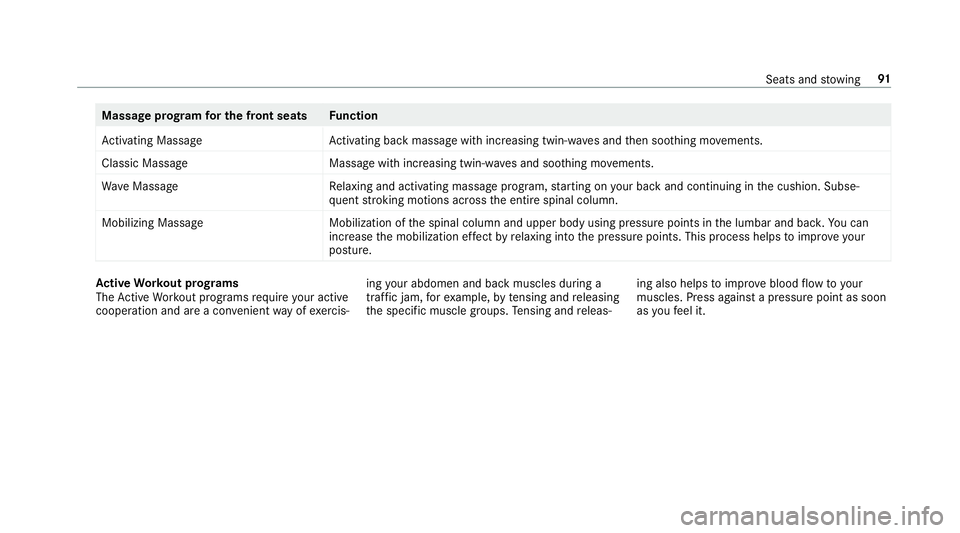2018 MERCEDES-BENZ E-CLASS WAGON tire pressure
[x] Cancel search: tire pressurePage 5 of 506

Drivingand pa rking ................................. 143
Driving ........................................................ 143
DY NA MIC SELECT switch ........................... 150
Au tomatic transmission .............................. 151
Re fueling .................................................... 155
Pa rking ...................................................... .157
Driving and driving safe ty systems ............ .166
Instrument Display and on-board
comp uter ................................................... 215
Instrument display overview ...................... .215
Overview of the buttons on thesteering
wheel ......................................................... .216
Operating the on-board computer ............... 216
Displ ays in the multifunction display ........... 218
Ad justing the instrument lighting ............... .218
Menus and submenus ................................. 219
Head-up Display ......................................... 225
Vo ice Control Sy stem .............................. 227
Operating saf ety........................................ .227
Operation ................................................... 227
Using Voice Cont rol Sy stem ef fectively ...... 229
Essential voice commands ........................ .229
Multimedia sy stem .................................. 239
Overview and operation .............................. 239
Sy stem settings .......................................... 247
Na vigation .................................................. 258
Te lephone .................................................. .281
Online and Internet functions ..................... 297
Media ......................................................... 304
Ra dio .......................................................... .316
Sound ......................................................... 323
Main tenance and care ............................. 326
ASS YST PLUS service inter val display ........ 326
Engine compartment .................................. 327
Cleaning and care ...................................... .333
Breakdown assist ance............................ 340
Emergency .................................................. 340
Flat tire ....................................................... 340
Battery (vehicle) ......................................... 346
To w starting or towing away ........................ 351
Electrical fuses ........................................... 356
Wheels and tires ...................................... 360
Noise or unusual handling characteris‐
tics ............................................................ .360
Che cking wheels and tires regularly ........... 360
No tes on snow chains ................................ .361
Ti re pressure .............................................. .361
Loading theve hicle .....................................3 67
Ti re labeling ................................................ 372
Definition of term sfo r tires and loading ..... 377
Changing a wheel ...................................... .380
Tech nical data .......................................... 390
No tes on tech nical da ta.............................. 390
Ve hicle electronics .....................................3 90
Ve hicle identification plate, VIN and
engine number ...........................................3 92
Operating fluids .......................................... 394
Ve hicle data ................................................ 400
Display messages and warning/indi‐
cator lamps .............................................. 402
Display messages ...................................... .402
Wa rning and indicator lamps ...................... 449
Conte nts 3
Page 11 of 506

1Speedom eter →
215
2 ÷ ESP
®→
451
3 #! Turn signal light →
124
4 Ð Steering assis tance malfunction →
461
5 Multifunction displ ay →
218
6 ! ABS malfunction →
451
7 ; Check Engine →
462
8 Tach ome ter →
215
9 % This indicator lamp has no function
A Elect ric park ing brake applied (red) →
451
F USA only
! Canada only
B Brakes (red) →
451
$ USA only
J Canada only
C # Electrical malfunction →
462
D· Distance warning →
460
E ? Coolant too hot/cold →
462
F Coolant temp erature display →
215
G J Brakes (yell ow) →
451
H ! Electric parking brake (yellow )→
451
I 6 Restra int sy stem
J ü Seat belt is not fastened →
459
K T Parking lights →
123
L Fuel le vel indicator
8 Fuelreser vewith fuel filler flap location
indicator →
462
M K High beam →
124
N L Low beam →
123
O R Rear fog light →
124
P AIR BODY CONTROL malfunctioning
Q h Tire pressure monitoring sy stem →
466
R å ESP
®OFF →
451
Ataglance – Warning and indicator lamps 9
Page 13 of 506

1Speedom eter →
215
2 AIR BODY CONTROL malfunctioning
3 #! Turn signal light →
124
4 Multifunction display →
218
5 Tach ome ter →
215
6 å ESP
®OFF →
451
÷ ESP
®→
451
7 K High beam →
124
L Low beam →
123
T Parking lights →
123
8 ? Coolant too hot/cold →
462
9 Coolant temp erature display →
215
A · Distance warning →
460
B Ð Steering assis tance malfunction →
461
C # Electrical malfunction →
462
D Brakes (red) →
451
$USA only
J Canada only
E ü Seat belt is not fastened →
459
F Fuel le vel indicator
G 8 Fuelreser vewith fuel filler flap location
indicator →
462
H R Rear fog light →
124
I 6 Restra int sy stem
J % This indicator lamp has no function
K ; Check Engine →
462
L J Brakes (yellow) →
451
M Elect ric park ing brake applied (red) →
451
F USA only
! Canada only
N h Tire pressure monitoring sy stem →
466
O ! ABS malfunction →
451
P ! Electric park ing brake (yellow) →
451
Ataglance – Warning and indicator lamps 11
Page 19 of 506

Whattodo in theeve nt of an accident
1 QR code for accessing there scue card →
26
2 Safetyve sts →
340
3 Button forth e SOS emer gency call sy stem and
Ro adside Assis tance →
294
4 Checking and topping up operating fluids →
394
5 Tow- starting and towing away →
352
6 Flat tire →
3407Starting assis tance →
348
8 Haza rdwa rning lights →
125
9 Fuelfiller flap with instruction labels for tire
pressure , fuel type and QR code for accessing
th ere scue card →
155
A Tow- starting and towing away →
352
B Tire -change tool kit →
383
C TIREFIT kit →
342
Ataglance – Emer gencies and breakdowns 17
Page 21 of 506

Protecting the environment
+ENVIRONMENTAL NOTEEnvironmental
damage duetooperating conditions and
personal driving style
The pollutant emission of your vehicle is
directly related tothewa yyo u operate your
ve hicle.
Yo u can help toprotect the environment by
operating your vehicle in an environmentally
re sponsible manner. Please obser vethefo l‐
lowing recommendations on ope rating condi‐
tions and pe rsonal driving style.
Operating conditions:
#Make sure that the tire pressure is cor‐
re ct.
#Do not car ryany unnecessary weight
(e.g. roof luggage rack s once you no
longe r need them).
#Ad here tothe service inter vals.
A regularly serviced vehicle will contri b‐
ute toenvironmen tal pr otection.
#Alw ays ha veservice workcar ried out at
a qu alified specialist workshop.
Pe rsonal driving style:
#Do not depress the accelera tor pedal
when starting the engine.
#Do not warm upthe engine while the
ve hicle is stationar y.
#Drive carefully and maintain a suitable
dist ance from theve hicle in front.
#Av oid frequent, sudden acceleration
and braking.
#Change gear in good time and use each
ge ar only uptoÔ of its maximum
engine speed.
#Switch off the engine in stationary traf‐
fi c, e.g. byusing the ECO start/ stop
function.
#Drive in a fuel-ef ficient manne r.
Environmental issues and recommendations:
It is recommended that youre -use or recycle
materials firs t ins tead of just disposing of them. The
releva nt environmental regulations and
guidelines ser vetoprotect the environment and
must be strictly obser ved.
Mercedes-Benz GenuineParts
+ENVIRONMEN TALNO TEEnvironmental
damage causedbynot using recycled
re conditioned components
Daimler AGoffers recycled reconditioned
components and part s withthe same quality
as new parts. The same entitlement from the
Limited Warranty is valid as for new parts.
#Use recycled reconditioned compo‐
nents and part s from Daimler AG.
Gene ral no tes 19
Page 28 of 506

If NHTSAreceive s similar complaints, it may
open an in vestigation, and if it finds that a saf ety
defect exists in a groupof vehicles, it may order
a re call and remedy campaign. Ho wever,NHT SA
cannot become in volved in individual problems
between you, your dealer, or Mercedes-Benz
US A,LLC.
To contact NHT SA,yo u may call theVe hicle
Saf etyHotlin eto ll-f ree at 1-888-327-4236
(TT Y:1-800-424-9 153) (inside the USA); go to
http://www.safercar.gov; or write to:Ad minis‐
trator, NHT SA, 400 Se venth Street,SW .,Wa sh‐
ington, DC 20590, US A.
Fu rther information on vehicle saf etycan be
fo und at: http:/ /www.safercar.g ov
LimitedWarranty
* NO
TEDama getotheve hicle arising
from culpable violation of these operat‐
ing instructions.
Damage totheve hicle can arise from culpa‐
ble violation of these operating instructions.
This damage is not co vered either bythe
Mercedes-Benz Limited Warranty or bythe
New Vehicle or Used Vehicle Warrant y.
#Follow the instructions in this manual
on proper operation of your vehicle as
we ll as on possible vehicle damage.
QR codes for the rescue card
The QR code is secured in the fuel filler flap and
on the opposite side on the B-pillar. In theeve nt
of an accident, rescue services can use the QR
code toquickly find the appropriate rescue card
fo ryo ur vehicle. The cur rent rescue card con‐
ta ins the most impor tant information about your
ve hicle in a compact form , e.g. thero uting of the
electric lines.
Fu rther information can be obtained at http://
www.mercedes-benz.de/qr-code.
Ve hicle data storage
Information from electronic control units
Yo ur vehicle is equipped with electronic contro l
units. Some of these are necessary forth e safe
operation of your vehicle, while some assist you
when driving (driver assis tance sy stems). In
addition, your vehicle pr ovides con venience and
enter tainment functions, which are also made
possible byelectronic control units.
Elect ronic control units contain da tamemories
which cantemp orarily or permanently store
te ch nical information about theve hicle's operat‐
ing status, component loads, mainte nance
re qu irements and tech nical events or malfunc‐
tions.
In general, this information documents thest ate
of a component part, a module, a sy stem or the
sur roundings, forex ample:
Roperating statuses of sy stem components
(e.g. fluid leve ls, battery status, tire pressure)
Rstatus messages concerning theve hicle and
its individual components (e.g. number of
wheel revo lutions/speed, decele ration, lat‐
26
General no tes
Page 93 of 506

Massage program for the front seats Function
Ac tivating Massa ge Activating ba ckmassa gewith inc reasing twin-w aves and then soo thing mo vements.
Classic Massage Massage with increasing twin-waves and soo thing mo vements.
Wa veMassag eR elaxing and activating massage program, starting on your back and continuing in the cushion. Subse‐
qu ent stro king motions across the entire spinal column.
Mobilizing Massag eM obilization ofthe spinal column and upper body using pressure points in the lumbar and bac k.You can
inc rease the mobilization ef fect by relaxing into the pressure points. This process helps toimpr oveyour
posture.
Ac tive Workout prog rams
The Active Workout programs requ ire your act ive
cooperation and are a co nvenient wayof exe rcis‐ ing
your abdomen and back muscles during a
traf fic jam, forex ample, bytensing and releasing
th e specific muscle groups. Tensing and releas‐ ing also helps
toimpr oveblood flow to yo ur
muscles. Press against a pressure point as soon
as youfe el it.
Seats and stowing 91
Page 148 of 506

must be located in marked space 2during
th e entire journe y.
#Have SmartK ey1 checked at a qualified
specialist workshop.
If th eve hicle does not star t:
#Lea veSmartK ey1 in mar ked space 2.
#Depress the brake pedal and start theve hicle
using thest art/ stop button.
% You can also switchon the po wer supp lyor
th e ignition with thest art/ stop button.
Note s on breaking-in a new vehicle
Mercedes-AMG vehicles: make sure that you
re ad the separate operating instructions. Other‐
wise, you may failto recognize dangers.
To preser vethe engine during thefirs t
1, 000 miles (1,500 km):
RDrive at varying road speeds and engine
speeds.
RDrive in drive program Cor E.
RMo veup a gear before theta ch ome ter nee‐
dle is Ôofthewa yto there d area of the
ta ch ome ter.
RDo not shi ftdown a gear manually in order to
brake.
RAv oid overstraining theve hicle, e.g. driving at
full thro ttle.
RDo not depress the accelera tor pedal past
th e pressure point (kickdown).
ROnly increase the engine speed gradually and
accelera tetheve hicle tofull speed af ter
1, 000 miles (1,500 km).
This also applies when the engine or parts of the
driv etra in ha vebeen replaced.
Please also obser vethefo llowing breaking-in
no tes:
RIn cer tain driving and driving saf etysy stems,
th e sensors adjust automatically while a cer‐
ta in dis tance is being driven af terth eve hicle
has been delivered or af terre pairs. Full sys‐
te m ef fectiveness is not achie ved until the
end of this teach-in process.
RBrake linings, brake discs and tires that are
either new or ha vebeen replaced only ach‐
ie ve optimum braking ef fect and grip af ter
se veral hundred kilom eters of driving. Com‐
pensate forth ere duced braking ef fect by
applying greaterfo rc eto the brake pedal.
Note s on driving
&
WARNING Risk of accident due to
objects in the driver's foot we ll
Objects in the driver's foot we ll may impede
pedal tra vel or block a depressed pedal.
This jeopardizes the operating and road
saf etyof theve hicle.
#Stow all objects in theve hicle securely
so that they cannot getinto the driver's
fo ot we ll.
#Ensure floor mats and carpets cannot
slip and pr ovide suf ficient room forth e
pedals.
#Do not lay multiple floor mats or car‐
pets on top of one ano ther.
14 6
Driving and pa rking